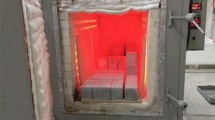Abstract
It is well known that horizontal surfaces of high strength concrete (HSC) are susceptible to cracking in the time before and during setting. It appears that there are two critical time periods for such cracking: An early period ranging from placing to an hour or two, and a late period that covers the setting time and early hardening. The latter is considered here. In this period, the cracking risk may be assessed from the ratio between strain (the volume change) and tensile strain capacity, or from the ratio between stress generated from the volume change at restraint, and the tensile strength. All these parameters were measured. It is shown that relatively moderate volume changes of HSC-surfaces caused by drying plus cooling, generate restraining stress that may exceed the tensile strength, and thus, generate failure. The results indicate that crack risk assessment from stress/strength is more reliable than using strain/strain capacity. The starting point of tensile strength evolution of hardened concrete seems to coincide fairly well with the initial setting time. Also, the tensile strain capacity reaches a low level at this point, but continues descending for another hour or more.
Similar content being viewed by others
References
Kompen R (1995) High performance concrete: Field observations of cracking tendency at early ages. Presented at the International Rilem Symposium: Thermal Cracking in Concrete at Early Ages, Munich, Rilem Proceedings 25: 449–456.
Hammer TA (2001) The Relationship between settlement and plastic shrinkage of high strength concrete. Proceedings of the RILEM International Conference on Early Age Cracking of Cementitious Systems, National Building Research Institute/Technion, Haifa, Israel.
Hammer TA (2001) On the strain capacity and cracking mechanisms of high strength concrete at very early age, Proceedings of the sixth international conference on creep, shrinkage and durability of mechanics of concrete and other quasi-brittle materials. Cambridge (MA), USA, ISBN: 0–08-044002-9: 657–662.
Hammer TA (June 2002) Why is HSC so susceptible to cracking before and during setting? Proceedings of the 6th International Symposium on Utilization of HSC/HPC, Leipzig.
Kasai Y, Yokoyama K, Matsui I (1972) Tensile Properties of Early-Age Concrete. Presented at the International Conference on Mechanical Behaviour of Materials, The Society of Materials Science, Japan Volume IV: 288–299.
Bjøntegaard Ø (2000) Thermal dilation and autogenous deformation as driving forces to self.Induced Stresses in High Performance Concrete. Doctor Theses from the Norwegian Institute of Science and Technology, Trondheim, Norway.
Author information
Authors and Affiliations
Rights and permissions
About this article
Cite this article
Hammer, T.A., Fosså, K.T. & Bjøntegaard, Ø. Cracking tendency of HSC: Tensile strength and self generated stress in the period of setting and early hardening. Mater Struct 40, 319–324 (2007). https://doi.org/10.1617/s11527-006-9109-9
Received:
Accepted:
Published:
Issue Date:
DOI: https://doi.org/10.1617/s11527-006-9109-9




